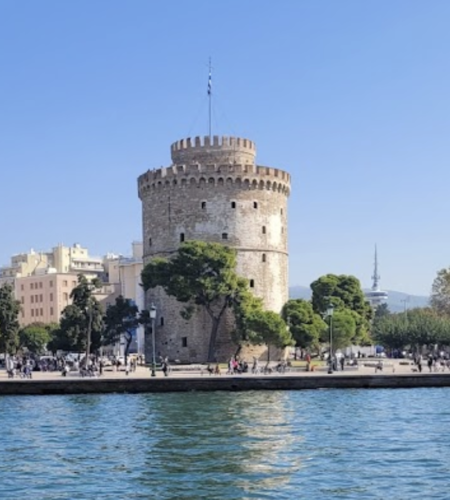Exploring the White Tower: Thessaloniki’s Iconic Landmark
Standing proudly on the waterfront of Thessaloniki, the White Tower is one of the city’s most recognizable and historic landmarks. This cylindrical tower, with its distinct whitewashed exterior, has served many roles over the centuries—from a defensive fortress and a prison to its modern incarnation as a museum. As a symbol of Thessaloniki’s resilience and vibrant history, the White Tower draws visitors from around the world, offering panoramic views of the city and the Thermaic Gulf along with insights into the city’s rich past.
A Fortress with a Complex History
The White Tower was originally built in the 15th century during the Ottoman Empire to replace an older Byzantine fortification. It was part of the city’s defensive walls, serving as a critical point for protecting Thessaloniki’s harbor and controlling access to the city from the sea. The tower’s strategic location made it an essential military stronghold during times of conflict.
In the centuries that followed, the White Tower underwent several transformations. During the Ottoman period, it was used as a prison and became infamous for its harsh conditions and executions, earning the nickname “Tower of Blood.” In the late 19th century, the tower was whitewashed as part of efforts to symbolically cleanse its grim past, giving it the name by which it is known today.
Architectural Features
The White Tower stands approximately 34 meters tall and is composed of six floors connected by a spiral staircase. Its circular design and thick walls reflect the military architecture of the period, designed to withstand sieges and protect the city’s defenses. The tower’s rooftop terrace offers breathtaking views of Thessaloniki’s waterfront, the surrounding cityscape, and the Aegean Sea, making it a favorite spot for visitors and photographers.
The White Tower Museum
Today, the White Tower is home to a museum dedicated to the history and culture of Thessaloniki. Operated by the Museum of Byzantine Culture, the exhibits cover a wide range of topics, from the city’s ancient roots and Byzantine heritage to its Ottoman period and modern development. The museum’s interactive displays, artifacts, and multimedia presentations provide a comprehensive overview of Thessaloniki’s evolution through the ages.
Highlights of the museum include:
- Historical Artifacts: Objects from Thessaloniki’s rich past, including ceramics, coins, and everyday items, offer a glimpse into the lives of its inhabitants over centuries.
- Multimedia Presentations: Modern technology brings history to life, with videos and interactive displays illustrating the city’s architectural and cultural transformations.
- Panoramic Rooftop Views: The museum experience culminates on the tower’s rooftop terrace, where visitors can enjoy sweeping views of Thessaloniki’s harbor and skyline.
A Symbol of Thessaloniki’s Identity
The White Tower is more than just a historical site; it is a symbol of Thessaloniki’s identity and resilience. Its transformation from a military fortress to a cultural monument mirrors the city’s journey through periods of conflict, change, and renewal. Today, the tower serves as a meeting point, a cultural hub, and a proud emblem of Thessaloniki’s heritage.
Activities and Nearby Attractions
The White Tower is located on the vibrant Nikis Avenue, Thessaloniki’s bustling waterfront promenade. After visiting the tower, visitors can enjoy a leisurely stroll along the seafront, explore nearby attractions, or indulge in local cuisine at one of the many cafes and restaurants in the area.
- Alexander the Great Statue: A short walk from the White Tower, this iconic statue commemorates the famous Macedonian leader, a key figure in the region’s history.
- Archaeological Museum of Thessaloniki: Just a few minutes away, this museum houses an impressive collection of artifacts from ancient Macedonia, offering deeper insights into the region’s history.
- Thessaloniki Concert Hall: For those interested in the arts, this modern venue hosts concerts, performances, and cultural events throughout the year.
Visitor Information and Accessibility
Location: The White Tower is centrally located on Thessaloniki’s waterfront, making it easily accessible on foot or by public transport.
Hours: Opening hours vary depending on the season, so it is recommended to check in advance.
Admission Fees: Tickets are required for entry, with discounts available for students, seniors, and groups. The rooftop terrace is included in the admission fee.
Accessibility: While the tower’s spiral staircase may pose challenges for visitors with mobility issues, the museum offers resources to make the experience as accessible as possible.
Official Website
For up-to-date information on opening hours, exhibitions, and events, visit the official website of the Museum of Byzantine Culture: mbp.gr.
Best Time to Visit
The White Tower is a popular destination year-round, but visiting in the early morning or late afternoon allows for a quieter experience and the best light for photography. The rooftop terrace is particularly stunning at sunset, offering unforgettable views of the city and sea.
A Must-See in Thessaloniki
With its rich history, stunning views, and engaging museum, the White Tower of Thessaloniki is an essential stop for anyone exploring the city. Whether you’re delving into the region’s past, admiring the tower’s architecture, or simply taking in the panoramic views from its rooftop, the White Tower offers a unique and memorable experience that captures the essence of Thessaloniki’s charm and heritage.


Comments